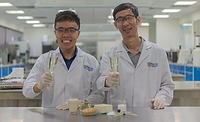Typhimurium causes an estimated 1.4 million cases of food poisoning each year in the U.S., and about 1,000 deaths. Because antibiotic resistance is a growing problem with Typhimurium, researchers are hopeful that their map will help identify possible new drug targets and reduce the threat of resistant strains.
The investigators identified 4,595 suspected genes in the Typhimurium genome, many of which were previously unknown. They include 156 probable membrane proteins that are potential drug or vaccine targets.
The researchers also found two previously unknown gene clusters required for producing the hair-like strands, or fimbriae, that cover the bacteria. The strands enable the bacterium to cling to cells that line the intestines. "These are also targets for potential therapies that might prevent the bacterium from attaching in the gut and thereby preclude infection," said Sandra Clifton, Ph.D., research instructor in the Department of Genetics at Washington University and group leader for the project.
By comparing the genome of Typhimurium to several closely related bacteria, researchers discovered that the bacterium contains a series of mostly previously unknown genes that are missing from subspecies of Salmonella that infect cold-blooded animals. "Those genes may enable Typhimurium to infect warm-blooded hosts," says Clifton.
In addition to researchers at Washington University, the Typhimurium team included investigators at the Sidney Kimmel Cancer Center in San Diego; the University of Calgary in Alberta, Canada, and Pennsylvania State University.

